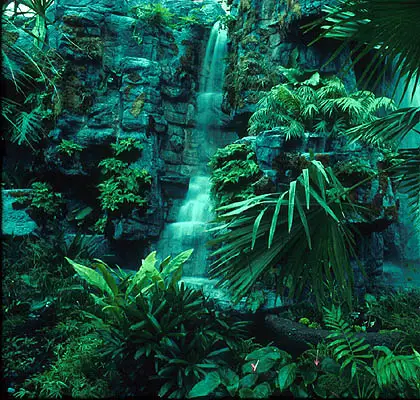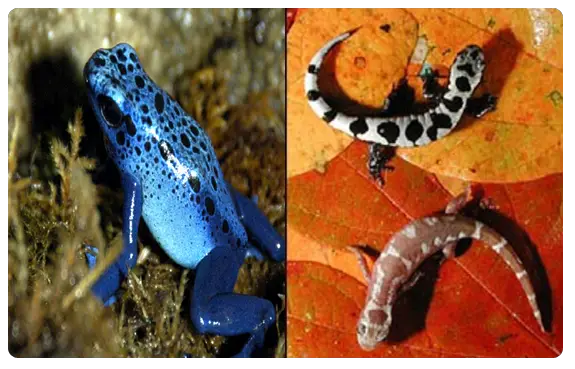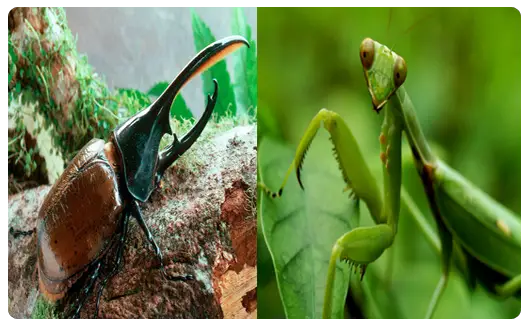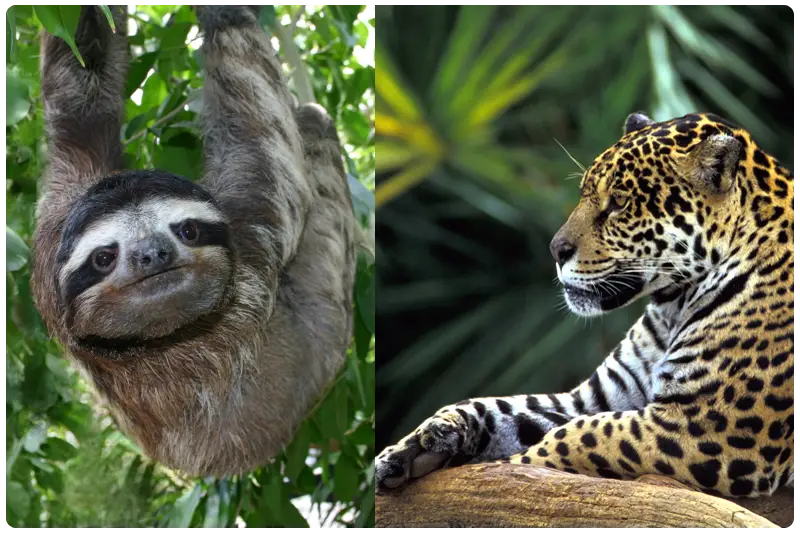Rainforests are the oldest living ecosystem on our planet and are incredible as well as beautiful. They only cover around 6 percent of the Earth’s surface, but include more than fifty percent of plant and animal species in the world. You can picture a rainforest as a tall, dense jungle with plenty of rain all through the year. Rainforest climates are typically very hot and humid, but the rainforest plants and animals living there have learned to adapt to these extremes.
 When we talk about rainforest facts, some foods we eat like chocolate, pineapple, and medicines we use are derived from rainforest plants and animals, and there are some ingredients which are only found in the rainforest climate.
When we talk about rainforest facts, some foods we eat like chocolate, pineapple, and medicines we use are derived from rainforest plants and animals, and there are some ingredients which are only found in the rainforest climate.
The Amazon Rainforest is the largest and covers more than a billion acres, and includes regions in Venezuela, Colombia, Brazil, as well as parts of Peru and Ecuador. Borneo rainforests at one time were very dense with swampy coastal mangrove forests and a mountainous interior. It was almost impossible to explore and pass through this rainforest and there were headhunters in the inaccessible parts of the island less than a century ago.
The second largest rainforest system of the world is the African rainforests. And some of the richest rainforests are in Madagascar, it is home to many unique plants and animals not found anywhere else. The Congo rainforest is renowned for its chimpanzees, gorillas and elephants, as well as that well-known forest tribe, the pygmies.
Rainforest ecotourism has caught the attention of numerous tourists and environmentalists, and instead of making your next trip to a hotel or a resort where you sit around most of the day or go shopping, you can experience your vacation in some of the most spectacular rainforests in the world and experience exotic, abundant wildlife and very unusual people.
About Rainforests
Table of Contents
Rainforests are distinctive for their dense forests and high amounts of annual rainfall often positioned in tropical areas. There are two types of rainforest: tropical and temperate.
Tropical Rainforests are frequently located between your Tropic of Capricorn and also the Tropic of Cancer. Regions that have Tropical Rainforest growth include Brazil and northern South America, West Central Africa, India and Southeast Asia, Indonesia, and Northeast Australia.
Temperate Rainforests can be found in several regions across the world such as the Pacific Coast of america and Canada, and various regions of Europe, Russia and Eastern Asia. Temperate Rainforest may often have more coniferous trees for example pines, firs and redwoods; whereas Tropical Rainforest contains more broad-leafed trees.
Tropical and temperate rainforests host an estimate of 30 to 50 million species of plants and animals. The exact number is difficult to determine as new species are constantly being discovered or dying out. The rainforest gets between 65-100 inches of rain per year.
Did you know?
50% of the earth’s animal species live in the rainforest, even though rainforests only cover 6% of the earth’s surface.

The rainforest consists of five layers; The emergent, the canopy , the understory, the shrub (part of understory), and the forest floor.
- First there is the forest floor which is on the bottom. It is the first layer of soil that houses the beginning of plants. It only receives about 2% of sunlight and plants have to adjust to the less sunlight. Thousands of species of ants, beetles, frogs and bugs can be found on the rainforest forest floor.
- The Understory and Shrub are the second and third layers. They are generally considered one layer. It is from 0 feet to 60 feet above the ground. Lizards, jaguars and tigers live at this level.
- The canopy is the fourth layer. Many species of birds live in the canopy layer of the rainforest such as the Gray Parrot and the Macaw. The canopy is from 60 to 130 feet. 50 percent of all plant species are found here. That’s half of all the plant life in the world!
- The last and tallest layer is the emergent. It is from 130 to 160 feet, and the tallest trees reach to here. It is home to bats, monkeys, and the Harpy Eagle.
Find Information About Animals In the Rainforest!
On a rainforest holiday, it is possible to spend days just bird watching and trekking and feeling wonder over the plethora of exotic sights and sounds of the rainforest. When you think of taking a vacation, you might want to give some thought to a rainforest holiday. While popular tourist spots will always be there, rainforests may disappear!
Amphibians of the Rainforest

Amphibians include animals such as frogs, toads, salamanders, caecilians, and newts. All amphibians are cold-blooded vertebrates. There are bout 6,500 species of Amphibians. Amphibian eggs do not have shells and require a moist place to stay alive. Amphibians lay their eggs in the water or moist places and will often undergo a metamorphosis into which most develop lungs and become adults. Amphibians posses the ability to breathe through their skin and a result, must keep their skin moist. Some amphibians known to inhabit the rainforest include: Red Eyed Tree Frogs, Poison Dart Frogs, Golden toads, Rainbow Toads, Gladiator Tree Frogs, Tomato Frogs, Blue Arrow Poison Frogs, and the Amazon Climbing Salamander.
Rainforest Arthropods

Arthropods are invertebrates that have jointed appendages, a segmented body, and an exoskeleton. Arthropods include animals such as the butterfly, spiders, crabs, scorpions, and many other animals. They make up the majority of all animals, amounting for more than half of the worlds species. The majority of arthropods lay eggs. Some arthropods, such as the scorpion, thrive in dry areas while others, such as the crab, require water to thrive. Arthropods indigenous to the rainforest include: Bird Eating Tarantulas, Karnar Butterflies, Atlas Moths, Millipedes, Centipedes, Comet Moths, Praying Mantises, and the Hercules Beetle.
Birds of the Rainforest

Birds are winged vertebrates that are characterized by having feathers, laying hard-shelled eggs and being warm-blooded. Around 10,000 species of birds exist. The majority of birds have a lightweight skeleton, making it possible for them to fly. They are known for having a unique digestive system and a complex respiratory system. They live a wide variety of habitats. Some birds known to inhabit rainforests include: Macaws, Harpy Eagles, Quetzals, Hummingbirds, Parakeets, Hoatzins, Royal Flycatchers and the Cassowary.
Mammals in the Rainforest

Mammals are vertebrates that are characterized by having hair, being warm-blooded, and possessing mammary glands. There are about 6,000 species of mammals. The majority of mammals give birth to live young and all mammals feed their young milk. Only five species of mammals called monotremes lay eggs. The majority of mammals are rodents. Some mammals indigenous to the rainforest include Bengal Tigers, Leopards, Jaguars, Lemurs, Amazon River Dolphins, Sloths, Chimpanzees, Bongos, Okapis, Capybaras, and the Capuchin monkey.
Rain Forest Reptiles

Reptiles are cold-blooded vertebrates characterized by having scales and laying eggs with shells. There are about 8,200 species of reptiles. The vast majority of reptiles lay eggs, although some give live birth. Reptiles include animals as alligators, crocodiles, snakes, lizards, turtles and tortoises. Reptiles live on every continent except Antarctica and do well in dry environments. Reptiles indigenous to the rainforest include Gaboon Vipers, Emerald Boas, Anacondas, Iguanas, Chameleons, Geckos, Caimans, Eyelash Vipers, and the Red Foot Tortoise.
Rainforest Conservation
Do you know that the rainforests are disappearing at a very fast rate? There are many of us who want to save the endangered rainforest and are striving toward that goal. Rainforest protection is not going to be easy, it will take the endeavor of numerous people and groups. People from many areas and trades have to work collectively to make sure that the rainforests and their plentiful species of plants and wildlife survive for our children to value and enjoy.
40 percent of the world’s tropical forests are rainforests, and rainforests comprise about 20 percent of all the forests on Earth. About 6 to 7 percent of our planet is covered by them but more than half of the plants and animal species live there. Every minute hundreds of trees are chopped off in the tropical rainforests and as you read this, our tropical rainforests are dwindling. According to current rainforest monitoring, the extensive destruction of tropical rainforests can be described as the worst ecological disaster on our planet.
There are some steps we can take to save the rainforests and ecosystems around the globe. It is important to make people aware the significance of the environment and what they can do for rainforest protection. We can refurbish the destroyed ecosystems by replanting more trees, especially to replace those lost where forests are being cut.
It also helps to educate and encourage each community to lead their lives in a manner which does not harm the environment. We should rise in support of projects and companies that are working towards rainforest protection and minimizing the depletion. Parks are another possibility, instituted to save the rainforests and the life thriving within it.
HOW CAN THE RAINFORESTS BE SAVED?
The Rainforests are disappearing very quickly, and saving them isn’t going to be easy. The good news is there are a lot of people who want to help save the rainforests.
A few steps that we can all do to help save rainforests and, on a larger scale, ecosystems around the world is remembered by the abbreviation TREES:
Teach others about the value of the environment and how they can help save rainforests.
Restore depreciated ecosystems by planting trees on land where forests have been cut down.
Encourage friends to live in a way that doesn’t hurt the environment
Establish parks to protect rainforests and wildlife
Support companies that behave in ways that minimize damage to the environment
